The Friends of the Wildflower Garden, Inc.
Trees & Shrubs of the Eloise Butler Wildflower Garden
The oldest public wildflower garden in the United States
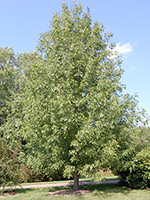
Common Name
White Ash (Cane Ash, American Ash)
Scientific Name
Fraxinus americana L.
Plant Family
Olive (Oleaceae)
White Ash is a large long-lived native deciduous tree growing to 80 feet in height and 2 feet in diameter with a straight trunk and a dense conical or rounded crown.
The largest known specimen in Minnesota is in Fillmore County - 156 inches in circumference, 87 feet high, 77 foot crown spread, scoring 262 points. The national champion is in Morris NJ - 255 inches in circumference, 115 feet high, 111 foot crown spread, scoring 398 points.
The bark is ashy-gray to dark gray, more whitish than other ashes, with diamond shaped furrows with corky scaly ridges on older trunks. Older trunks are usually free of lower branches.
Twigs are stout, olive green initially turning gray, hairless with leaf scars that are round at the bottom and notched at the top. The brown lateral buds rise from this notch. The terminal bud is large, scaled and flanked by smaller lateral buds.
Leaves are opposite and pinnately compound, 8 to 12 inches long, with 7 (sometimes 5 to 9) dark green paired leaflets (exc. the terminal leaflet which is single). These are ovate to elliptical, with margins that are either almost smooth or finely saw-toothed. Each leaflet is stalked and the leaf has a much longer stalk. The underside of the leaflet is paler, almost whitish, hence an allusion to the common name, although the white sap also contributes to the name. Fall color is yellow to purplish.
Flowers: The tree is dioecious, that is the male and female flowers are on different plants. Both appear before the leaves in small clusters. They are only 1/8 inch long, with a small tubular calyx, without corollas and form near the branch tips. Male flowers are yellow-green to purplish, on the prior year's wood and have two stamens with long anthers. The female flowers have a pistil and a single style and form also on the prior years wood. Both male and female flower clusters are tightly composed when formed, then the male flowers expand to expose the stamens and the female clusters greatly expand to the shape of a loose panicle. Flowers are cross pollinated by wind but male flowers shed pollen up to 10 days prior to the female flowers being receptive, thus multiple trees are needed for good seed production.
Seed: Female flowers mature to a single narrow winged samara, 1 to 2 inches long, that is rounded in appearance toward the base with a rounded seed cavity for the small seed, and the wing of the samara does not extend beyond the rounded seed cavity of the samara. These are greenish initially and turn brown, mature in autumn and disperse by wind in fall and winter. They do not germinate until the following spring as a cold stratification period is needed. Trees usually need to reach 3 to 4 inches in diameter before they bear any significant seed.
Habitat: White Ash grows best on well-drained moist soil with full sun. The root system is shallow and spreading. It can re-sprout from the root crown. The color of the new wood is white, thus adding more reasons for the common name. Heartwood is reddish.
Names: The genus, Fraxinus, is the old Latin name for this genus meaning 'spear'. Ash wood, being tough and elastic, was originally used for spears and bows in the old world. The species, americana means 'of America' as the tree is a new world species. The author name for the plant classification - 'L.' refers to Carl Linnaeus (1707-1778), Swedish botanist and the developer of the binomial nomenclature of modern taxonomy.
Comparisons: White Ash is easily confused with Black Ash (F. nigra) and Green Ash (F. pennsylvanica). Comparison of the samaras is the best method of identification, although the leaflets of White Ash are more whitened on the underside and the leaf scars have a definite notch at the top side where the new buds arise. Black Ash leaflets do not have stalks.
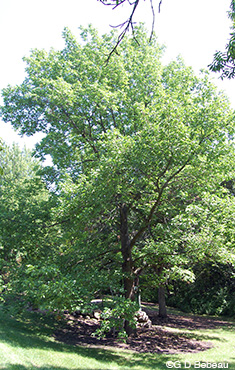
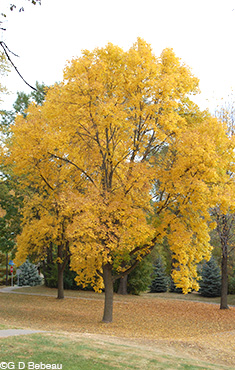
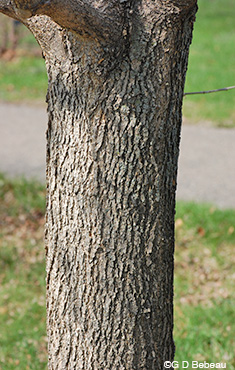
Above: 1st photo - A white ash of mature size. 2nd photo - Fall color of the white ash. 3rd photo - Bark is ashy-gray to dark gray with diamond shaped furrows with corky scaly ridges on older trunks
Below: 1st photo - Spring twig showing prior year growth - olive green color. Terminal buds are flanked by lateral buds. 2nd photo - This spring twig of the prior year's growth shows the semi-circular leaf scars that have a notch at the top where the new lateral buds emerge. 3rd photo - The terminal leaflet of the compound leaf. Each leaflet has a short stalk. Margins may be entire or may have a few shallow teeth near the tip.
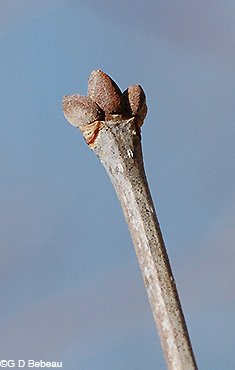
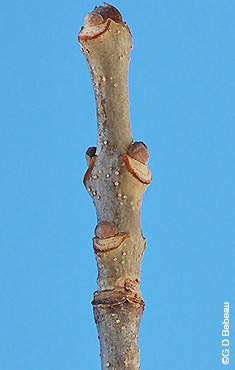
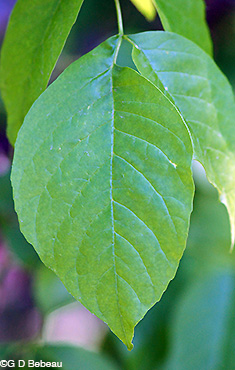
Below: The compound leaf 4 to 8 paired leaflets plus the terminal leaflet.
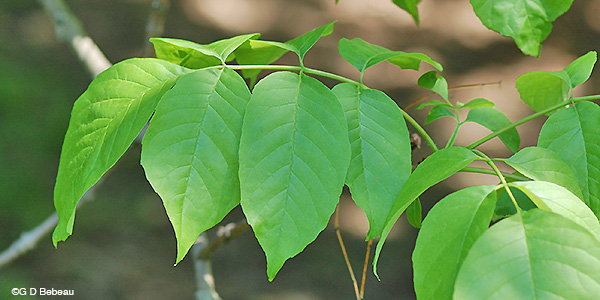
Below: Flowers of White ash form at the tips of old growth in a tightly composed cluster. Each flower is only 1/8 inch long. 2nd photo - Male flowers before elongation.
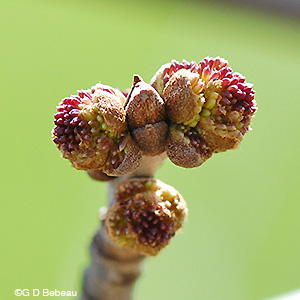
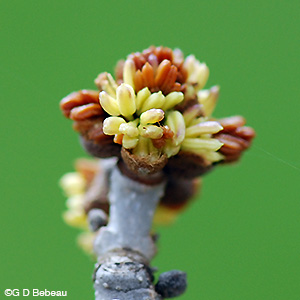
Below: 1st photo - Female flowers just beginning to expand. 2nd photo - Fully extended female flowers.
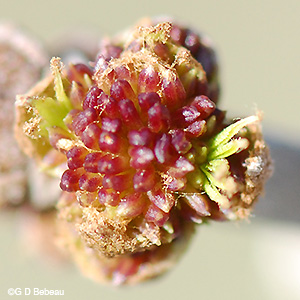
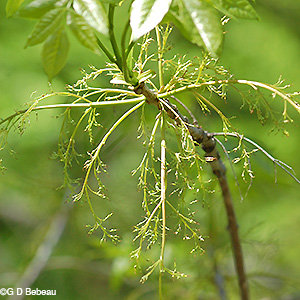
Below: Fully extended male flowers.
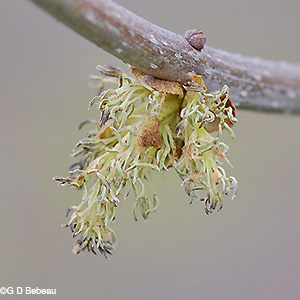
Below: 1st photo - Mature samaras of White Ash have a rounded seed cavity near the base and the wing does not extend beyond the rounded seed cavity of the samara.
Comparison: Ash samaras are a key distinguishing characteristic of the three common species. Position of the wing vs the seed and thickness of the seed are important. Overall length and width are variable between trees within a species and not useful.
F. nigra has a flatten broad seed with the wing extending to the base of the seed cavity. F. americana has a noticeably thick seed, rounded, and the wing does not extend beyond the seed cavity. F. pennsylvanica has a smaller seed with the wing extending into the seed cavity, but not all the way to the base.
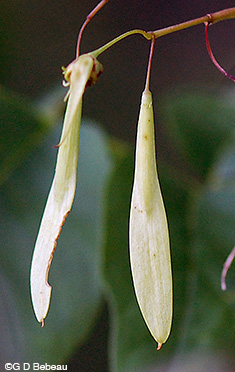
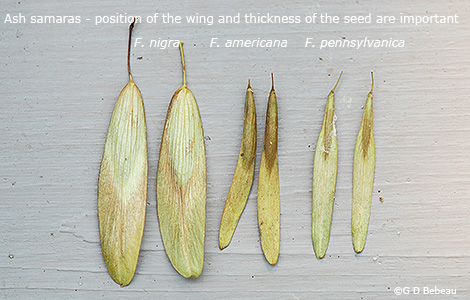
Notes: White Ash is believed to be indigenous to the Garden as Eloise Butler catalogued it on April 29, 1907. She also planted it in May 1909 with plants obtained from the Park Board Nursery, located at the time, at Glenwood Lake [now named Wirth Lake]. In North America it is found in the Eastern half of the U.S., reaching westward to Minnesota on the north and the central plains further south. In Canada it is found in Ontario, P E Island and Quebec. Within Minnesota it is quite restricted with native populations only known from 14 counties on the eastern side of the state with Mille Lacs and Pine county on the north and Fillmore and Houston on the south. Only three species of ash with known populations are native to Minnesota, White Ash plus Black Ash (F. nigra) and Green Ash (F. pennsylvanica).
Uses: White Ash wood is hard and strong, second only to hickory for use in tool handles, baseball bats and other sports equipment. The wood is used in furniture, boats and other areas where a strong dense wood is desired. It is useful as an ornamental if grown in the open, but it is a slow-grower and has had more pest problems than the Green Ash (ash yellows being the most serious) and with the advent of the Emerald Ash Borer another serious pest is on the scene and the Green Ash is even more severely affected.
Historically: The uses of the tree in early times are explained by Francois Michaux in his three volume work - North American Sylva.
“In large trees the perfect wood [heartwood] is reddish and the sap is white. This wood is highly esteemed for its strength, suppleness and elasticity, and is employed with advantage for a great variety of uses, of which I shall mention only the most common. It is always selected by coach-makers for shafts, for the jellies of wheels, and at New York and Philadelphia for the frame of carriage-bodies; by wheelwrights it is used for sledges and for the handle of wheel-barrows; in the District of Maine it replaces the White Oak for the circular back of Windsor chairs, scythe and rake handles, the hoops of water-pails, the circular piece of butter boxes, sieves and large spinning-wheels, which are manufactured principally at near Boston, are of White Ash; and in Connecticut it is usually preferred for wooden bowls. In the District of Maine it is extensively used for staves, which are of a quality between those of White and those of Red Oak and are esteemed the best for containing salted provisions.
It is admitted also into the lower frame of vessels, but is considered inferior to the Yellow Birch and to the heart of the Red Beech. In all the Atlantic States the blocks used in ships and the pins for attaching the cordage are of Ash, for which purpose the White Ash is employed in the northern and the Red Ash in the southern ports. On account of its strength and elasticity, the White Ash is esteemed superior to every other wood for oars, and second only to the Hickory for handspikes. In these forms it is exported to England and to the West Indies. It is also sent to England in planks, and is acknowledged by Oddy, in his treatise on European Commerce, to be superior in many respects to the Common Ash.” (Ref. #26d)
Francois Andre Michaux (1770-1855) French botanist, was the son of botanist Andre Michaux. He traveled with his father in the United States and his monumental work incorporates his father’s notes.
Superstition: Eric Sloan noted in his book Sketches of America Past that White Ash was frequently used for house doors and that “a superstitious person might put a Maltese cross in the lower section and thereby make a ‘witch door’ to keep out the evil spirits, or frame the door with ash to make the spell more potent. The ash tree was thought to have special magic to ward off sickness and evil spirits and no snake would cross a barrier of ash leaves.” Curiously, Thomas Nuttall's Supplement to a later edition of Michaux's book in the reference given above said the same about snakes.
He wrote: The leaves and branches of the White Ash are said to be poisonous to serpents, and the leaf to cure their bite. No rattlesnakes are found in White Ash swamps. An ash leaf rubbed upon the swellings caused by mosquitoes, removes the itching and soreness immediately. The same effect is produced on the poison occasioned by the sting of the bee.
Return to -- Site Plan/Archive Index --or-- List of Common Plant Names -- or -- List of Scientific Names -- or --Home Page - - - Back to top.
References: Plant characteristics are generally from sources 1A, 32, W2, W3, W7 & W8 plus others as specifically applied. Distribution principally from W1, W2 and 28C. Planting history generally from 1, 4 & 4a. Other sources by specific reference. See Reference List for details.
 Identification booklet for most of the flowering forbs and small flowering shrubs of the Eloise Butler Wildflower Garden. Details Here.
Identification booklet for most of the flowering forbs and small flowering shrubs of the Eloise Butler Wildflower Garden. Details Here.
©2013
Friends of the Wildflower Garden, Inc. Text and photos are by G. D. Bebeau unless otherwise credited. "www.friendsofeloisebutler.org"
013121